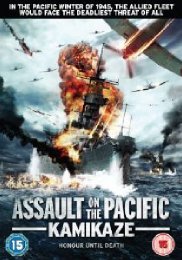Assault On The Pacific: Kamikaze
Assault On The Pacific: Kamikaze
By 1945 the war in the Pacific was ever turning to victory by the US forces, the carrier battles in 1942 bringing huge losses of ships, sailors, planes and pilots for the Imperial Japanese Navy Air Service. The Japanese war planners, similar to Hitler's own plans, had planned for a quick war and weren't geared up industrially to replace the lost equipment or men. It was becoming noticeable to the Japanese High Command that as the advance towards Japan was progressing by the US, that Japanese planes were both outnumbered and outclassed by their counterparts. In 1944 the Japanese were increasingly relying on inexperienced aviators straight out of flight school and obsolete planes, and up against a more experienced enemy it was no shock that the Japanese lost over 400 carrier based planes and pilots.
And so, in desperation, the Kamikaze squadrons were formed. In direct translation, Kamikaze means "divine wind" and although Kamikaze was the term that stuck, these squadrons were initially called Special Attack Corps. Assault On The Pacific: Kamikaze is a Japanese film that follows in the footsteps of others such as The Pacific Battleship Yamato, telling the story from the perspective of those involved.
Vice Admiral Onishi of the Japanese Imperial Navy decides that the Kamikaze strategy is one that must be implemented in order to save Japan, stating that Japan's goal of freeing like-coloured races from the oppression of the white man must not be forgotten in Japan's history - whilst seemingly forgetting the atrocities his fellow countrymen were committing in Indo-China and across the rest of Asia.
Over 5,000 pilots were sent to their deaths, 2,800 of them sinking 47 Navy ships, damaging 368 others, killing 4,900 sailors, and wounding over 4,800. Despite all teh protection, including radar detection and massive anti-aircraft barrages, some 14% of Kamikaze pilots broke through to score a hit on a ship and around 8.5% of ships hit by them ending up sinking.
The events of the film centre around a small restaurant in the town of Chiran, near the Japanese Special Attack Squadron airfield, where the middle aged female owner is known to the young trainee airmen as Auntie, and this central character also provides narration for the film. The young airmen are aged between 18 and 20 and face the prospect of dying in their thousands before they've experienced anything that life has to offer.
Whilst some, living up to the legend, are volunteers who look to do their duty to their Emperor, it is clear that some are not volunteers at all - some are blackmailed into it by families and there was a definate element of peer pressure involved. Those who died honourably were to be enshrined at the Yasakuni memorial, a special honour as this was the only shrine deifying the common man that the Emperor would visit, twice a year, to pay his respects. This honour is used to placate an ill pilot who cannot fly with the rest of his squad to their deaths, the leader promising him that they will wait for him at Yasakuni before heading to the afterlife.
This is a pretty good historicial dramatisation of the events and lives of these young pilots who gave their lives, often in vain. It's certainly no propaganda film as it lingers sometimes on the futility of throwing away the lives of good pilots, but it isn't without its flaws. Dialogue between characters tends to be full of dramatic pauses and overblown rhetoric, and the actions of the male characters, and to some extent the female, are all very rigid and formal. It could well be an accurate reflection of life during that time for the Japanese, but it feels quite childish and over-emotional. It can be also be quite disconcerting when the actors burst into song, something they tend to do quite frequently. I'm not sure how melodic this sounds to Japanese ears, but it just sounds awful to me.
Events are covered pretty honestly with the mechanical integrity of the Kamikaze planes one of the reasons why there were fewer successful attacks than anticipated. With a lack of spare parts, the Japanese mechanics struggled to get the older planes up in the air and this then put added pressure on the pilots who were expected not to return. One example was a pilot called Tabana who returned 7 times due to mechanical problems, publically harangued for cowardice and then sent on his way for an eighth time. With the chief mechanic giving his assurance that the plane was air worthy, Tabana took off, promptly stalled and ploughed straight into the ground, his payload exploding instantly. The instant grief of those watching was not that Tabana was dead, but that he had been unable to die an honourable death in combat.
Potential viewers should note that there is very little action in this film, it's mainly a drama about the pilots prior to flying to their deaths, and it's more than a little long at 130 minutes. In fairness it could do with a spot of editing and a 20 minute chunk removed from the end of the film.
Still a worthy watch though, especially for those interested in seeing events portrayed from the other side...

































Your Opinions and Comments
Be the first to post a comment!